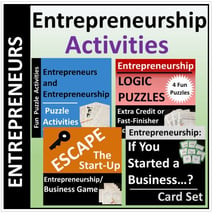Business Education | Entrepreneurship | Student Engagement
How To Think Outside the Box with Entrepreneurship Activities
Emma plays a critical role in facilitating communication between valued educators and AES, daily. It's paramount for her to understand the needs and perspective of our teachers to ensure our mutual success, and add value wherever possible.
High school business education teachers have an interesting mix of courses to teach.
While required courses may vary among schools or districts, nearly every business teacher needs more interesting ways to teach one key area: entrepreneurship.
There are many options out there to teach entrepreneurship in high school, and these can be excellent classroom resources.
But if you’re like most teachers, you want to mix it up with entrepreneurship activities and projects to supplement your standard lessons.
So, how can you think outside the box when it comes to teaching entrepreneurship?
We’ve got three ideas to get you started!
1. Incorporate a Variety of Entrepreneurship Activities
The most straightforward way to blend your classroom is with activities!
One of the best resources for finding engaging classroom activities is Teachers Pay Teachers.
Specifically, this Entrepreneurship Activities Bundle is the perfect choice for any teacher looking for a variety of activities!
In the bundle, you’ll find four different options for high school entrepreneurship activities:
1. Entrepreneurship Business Game: Escape the Start-Up
This game is a great activity to kick off your lessons on entrepreneurship. Students solve puzzles to decipher a code needed to “escape” the scenario of being locked inside a room. Each puzzle in the game includes entrepreneur-related topics and concepts.
You could have students either work independently or in small groups to complete the puzzles and escape the “locked room.”
2. Entrepreneurship Card Set Group Activity
This group activity is a way to get your high schoolers thinking creatively and cooperatively from the perspective of a business owner.
The resource includes 40 question cards that you can use to spur discussions all related to the overarching concept of “If you started a business…” A few examples include:
- …what would you do if you received a bad review from a customer?
- …how would you identify and hire qualified employees?
- …what skills would you need to make the company a success?
3. Entrepreneurship Logic Puzzles
These four logic puzzles are perfect “brain break” activities that you can use at practically any time in your syllabus.
Your students will work independently to use their critical thinking skills to solve logic puzzles about entrepreneurs and their businesses.
4. Entrepreneurship Puzzle Activities
These last activities are a great way to introduce or reinforce the principles of entrepreneurship in your classroom. You’ll find a word search, crossword puzzle, and more!
Overall, the activities in this bundle will add a lot of hours to your high school entrepreneurship lessons, and the bundle is well worth $7!
Once you’ve found a few ways to work these activities into your syllabus, consider trying our next idea to really go the extra mile!
2. Add Excitement to Your Entrepreneurship Lesson Plans with Shark Tank Fridays
Many high school business teachers are using the TV show Shark Tank to talk about entrepreneurship with students.
Adding “Shark Tank Fridays” to your curriculum is a great way to incorporate open-ended discussions in your weekly entrepreneurship lessons.
For this activity to run smoothly, however, you need to do some work up front.
Preparation:
Start by choosing the episodes or clips of Shark Tank you want to use. Pick a variety of pitches and include ones that end with a deal and others that don’t.
It’s a great idea to choose some pitches made by younger people to show your students that anyone can be an entrepreneur!
Once you’ve chosen the episodes you plan to use, it’s time to create your discussion questions.
You can use standard questions you ask for each pitch, such as:
- What problem does this product solve?
- Who would buy this product?
- Do you think a shark will make a deal? Why or why not?
It’s also a good idea to have a few “extra” questions that you mix up each time.
Consider asking questions that relate to the concepts you covered that week. These could include:
- How would you describe the entrepreneur’s demeanor?
- If you were the entrepreneur, what would you have done differently in the initial pitch?
- What risks did the entrepreneur take when building their business?
Now that you’ve got your lists together, it’s time to introduce Shark Tank Fridays to your class!
In Class:
On your first Shark Tank Friday, explain to your students that you’ll be watching entrepreneurs pitch their ideas and that you’ll be pausing for discussions throughout the class. Make sure you ask students to raise their hands rather than call out their answers.
By being up front about exactly what will happen and what is expected, everything will run smoother. Once everyone is on the same page, start the episode!
Play the first pitch up until the entrepreneur opens the floor for the sharks to ask questions.
After the entrepreneur’s pitch, ask your first two questions -- what problem does this product solve and who would buy it?
After a couple of students have raised their hands and answered, resume the episode.
At this point, your students will see what types of questions the sharks ask and how the entrepreneur answers.
Ultimately, the entrepreneur will either end up with an investment or leave without one.
After the final decision is made, pause the episode again.
Now you can use some of your more in-depth questions to really get the discussion going.
Start polling students on whether they thought the sharks would make a deal and have them explain their answers.
After that, transition to the questions you wrote that pertain to the lessons you taught this week. Open the class up for discussion and let your students go in-depth with their thoughts and opinions.
Just be sure to keep everything on track if the conversation starts to stray too far from the core of your discussion.
Overall, it may take a couple of days for everyone to get used to this style of class. But once you’ve got the rhythm down, Shark Tank Fridays are great additions to your entrepreneurship lessons.
You may even be surprised at how many students look forward to it each week!
3. Wrap Up Your Entrepreneurship Lessons with a Reflection Activity
While adding more engaging activities to your lessons can make a big difference day to day, including student self-reflection is just as important.
With a complex topic like entrepreneurship, it’s crucial to provide a way for students to reflect on what they’ve learned and how it has changed their viewpoint.
At the end of your unit or course, provide your students with a few prompts for reflection. Some ideas include:
- How do you think being an entrepreneur affects a person’s life?
- Have these lessons made you think differently about entrepreneurs? How so?
- Before this class, had you thought about becoming an entrepreneur? What about now?
You can choose to have students work on these reflection questions either in class or as homework.
Either way, the most important thing is for your students to reflect on what they’ve learned and think about how it could shape their futures!
Where to Go from Here with Teaching Entrepreneurship
So now you’ve got a bundle of activities, a plan for Shark Tank Fridays, and the perfect way to wrap up your entrepreneurship lessons.
What’s next?
The next step is to get some tried-and-true lesson plans that you can use to fill your curriculum.
Don’t worry -- we’ve got you covered. Check out the four best places to find entrepreneurship lessons by clicking below!


